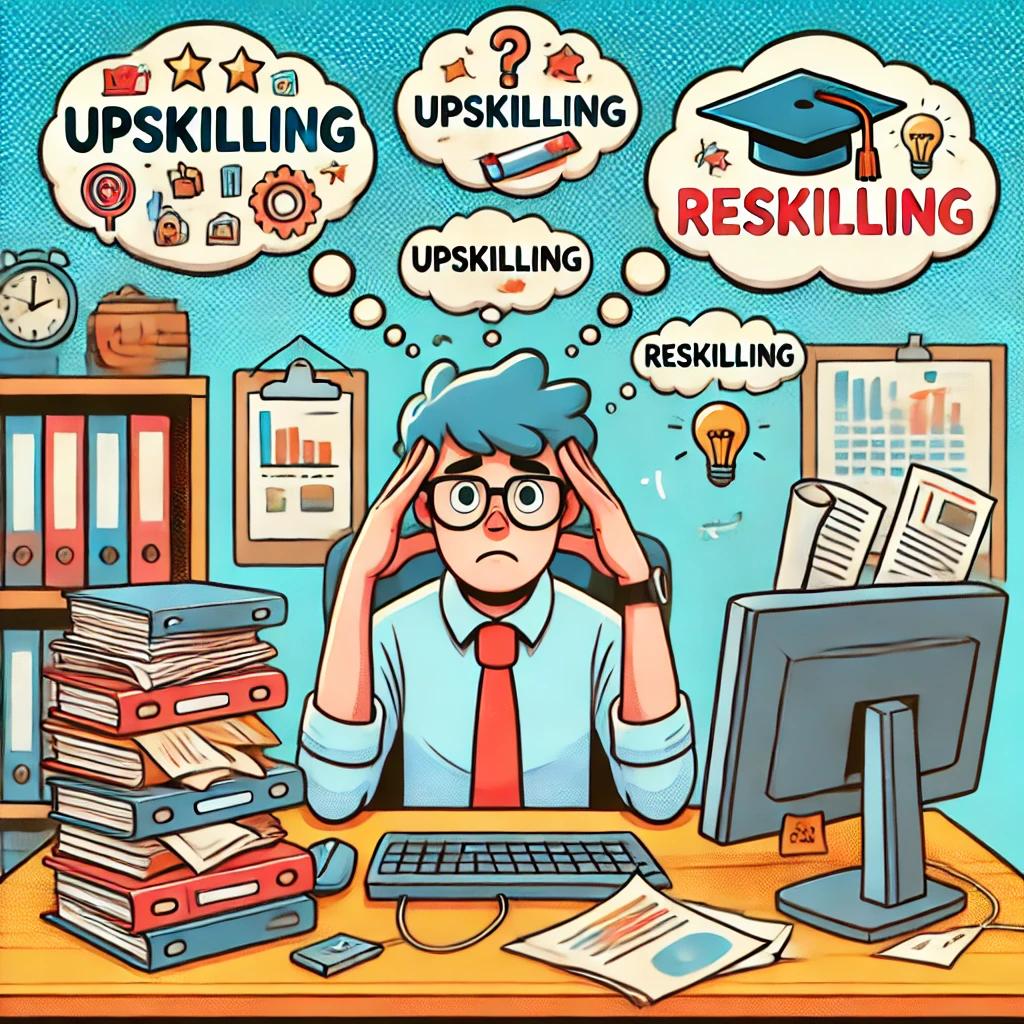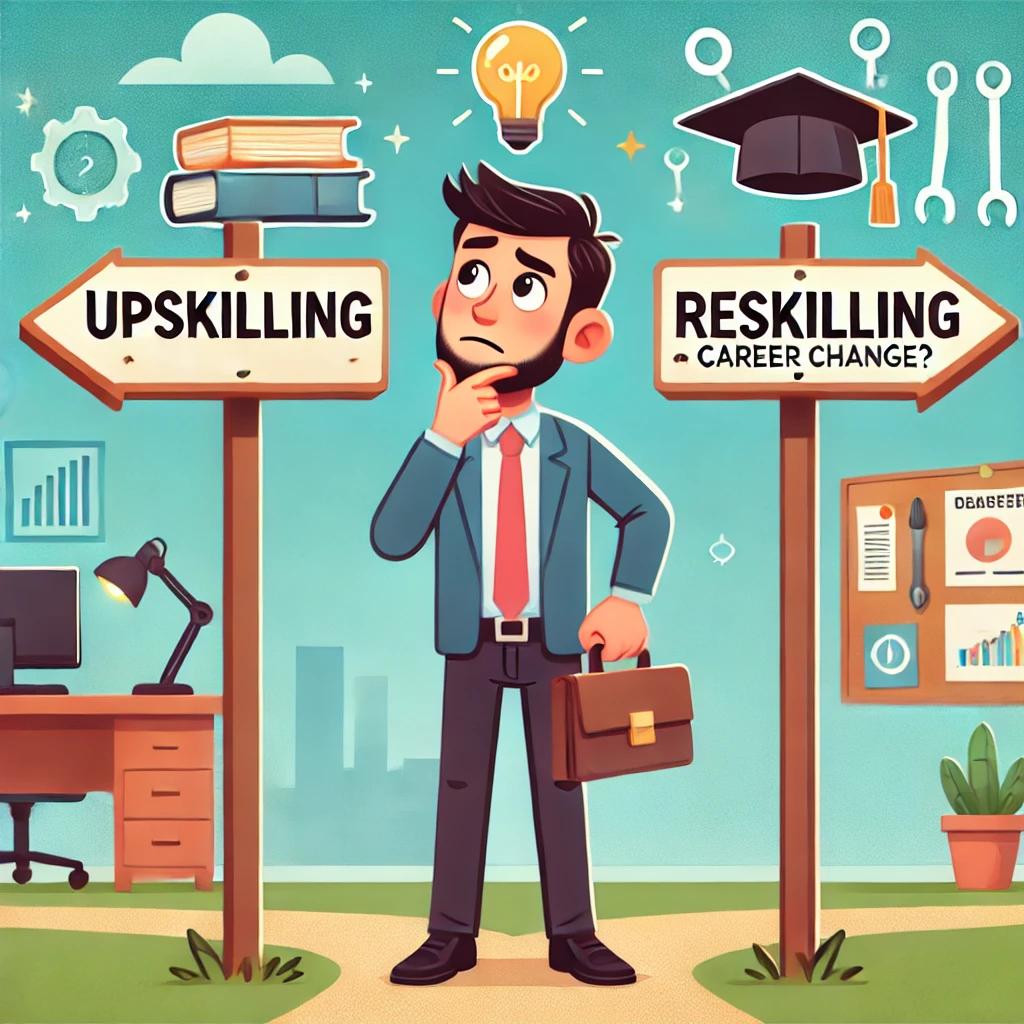Introduction
In today’s rapidly evolving job market, the need for continuous learning has never been more critical. The traditional career path, where employees could rely on a static set of skills for decades, is becoming a thing of the past. Technological advancements, industry disruptions, and shifting market demands are constantly reshaping the workplace, making it essential for employees to adapt to these changes through upskilling and reskilling.
Upskilling involves enhancing existing skills or acquiring new ones that align with the current trends and demands in your industry. On the other hand, reskilling refers to learning completely new skills to transition into different roles or industries. Both strategies are key to staying relevant, competitive, and secure in one’s career. As the workplace landscape continues to change, those who embrace upskilling and reskilling are better positioned to seize new opportunities and achieve career growth.
In this blog, we will explore why upskilling and reskilling are crucial for career advancement, how you can effectively pursue these learning opportunities, and share a real-life example of an individual who transformed their career through continuous learning.
Why Upskilling and Reskilling Matter
The rapid pace of technological advancements and the evolving demands of the job market have made upskilling and reskilling more critical than ever. Here’s why these practices are essential for career advancement:
1. Adapting to Technological Changes
As automation and AI continue to transform industries, many traditional roles are becoming obsolete. Upskilling allows employees to stay current with new technologies, making them more efficient and effective in their roles. For instance, learning new programming languages or mastering data analysis tools can ensure that professionals remain valuable assets to their organisations .
2. Staying Competitive in the Job Market
The job market is more competitive than ever, with employers increasingly seeking candidates with up-to-date skills. By continuously learning and adapting, employees can stay ahead of the curve and remain competitive in their fields. Upskilling and reskilling can open doors to new career opportunities, allowing professionals to transition into high-demand roles .
3. Career Progression Opportunities
Upskilling is a powerful tool for career advancement. Employees who actively seek to improve their skills are often seen as proactive and committed, qualities that can lead to promotions and greater responsibilities within their organizations. Reskilling, on the other hand, can provide the foundation for a complete career shift, opening up entirely new paths for growth and development .
4. Enhancing Job Security
In an era where job roles are constantly changing, upskilling and reskilling can significantly enhance job security. Employees who continuously learn and adapt are more likely to retain their positions, even as industries evolve. Moreover, those who acquire new skills can transition to other roles within their organizations, reducing the risk of unemployment .
5. Building Confidence and Job Satisfaction
Learning new skills and successfully applying them in the workplace can boost an employee’s confidence. This newfound confidence often translates into higher job satisfaction, as employees feel more capable and engaged in their work. Moreover, mastering new competencies can lead to personal fulfilment, as professionals take pride in their ability to meet new challenges .

How to Effectively Upskill and Reskill
Upskilling and reskilling are essential for staying relevant in today’s fast-changing job market. Here’s how you can effectively pursue these learning opportunities:
1. Identify Industry Trends
The first step in upskilling or reskilling is to understand which skills are in demand in your industry. Stay informed about the latest trends by following industry news, attending conferences, and networking with professionals in your field. This will help you identify which skills are becoming essential and where there may be gaps in your current abilities .
2. Utilize Online Learning Platforms
Online platforms like Coursera, Udemy, and LinkedIn Learning offer a wide range of courses that can help you acquire new skills or enhance existing ones. These platforms provide flexibility, allowing you to learn at your own pace and apply new knowledge immediately in your job. Many of these courses also offer certifications that can boost your resume .
3. Seek Mentorship and Coaching
Mentorship can be a powerful tool in your upskilling or reskilling journey. A mentor can provide valuable guidance, helping you navigate your career path and identify the most beneficial skills to learn. Consider reaching out to experienced professionals in your field or joining mentorship programs to gain insights and support .
4. Participate in Workshops and Seminars
Workshops and seminars offer hands-on experience and opportunities to learn from industry experts. These events can provide in-depth knowledge on specific topics and allow you to ask questions and engage with others who are also focused on upskilling or reskilling .
5. Join Professional Networks
Being part of a professional network can keep you connected with industry developments and provide access to exclusive learning opportunities. Networking with peers can also expose you to new ideas and resources that can aid in your skill development .
6. Apply New Skills on the Job
One of the best ways to solidify new skills is by applying them in your current role. Look for opportunities within your job where you can practice what you’ve learned. This not only reinforces your learning but also demonstrates your value to your employer .
7. Pursue Relevant Certifications
Certifications in relevant skills can set you apart from other professionals in your field. Many industries recognise certifications as proof of expertise, and they can lead to career advancements or new job opportunities .
8. Set Clear Career Goals
Having clear goals can help you stay focused and motivated throughout your upskilling or reskilling journey. Whether you aim for a promotion, a career change, or simply to stay competitive, setting specific, measurable goals will guide your learning efforts and keep you on track .
Real-Life Example: A Career Transformation Through Upskilling

To illustrate the power of upskilling and reskilling, let’s look at the story of Priya, a marketing professional who successfully transformed her career by embracing continuous learning.
Priya’s Background
Priya started her career as a traditional marketing executive in a mid-sized company. Her role primarily involved managing print advertisements, direct mail campaigns, and event marketing. As digital marketing began to dominate the industry, Priya realized that her skill set was becoming outdated. She noticed that most of her colleagues were proficient in digital tools, and she felt increasingly left behind.
The Decision to Upskill
Determined to stay relevant, Priya decided to upskill. She enrolled in online courses focused on digital marketing, including social media management, SEO, and data analytics. Priya dedicated her evenings and weekends to studying, ensuring that she could still manage her work responsibilities while learning.
Applying New Skills
As Priya gained confidence in her new skills, she started applying them at work. She proposed and led a small-scale digital campaign for her company, which delivered impressive results. Her ability to combine her traditional marketing expertise with new digital strategies caught the attention of her managers, leading to more opportunities to work on digital projects.
Career Advancement
Priya’s commitment to upskilling paid off when she was promoted to Digital Marketing Manager. In her new role, she was responsible for overseeing the company’s entire online presence, including social media, email marketing, and content strategy. The skills she acquired through continuous learning not only saved her from potential obsolescence but also propelled her career to new heights.
The Impact of Reskilling
Inspired by her success, Priya didn’t stop at upskilling. She decided to reskill by diving into data science, a field that was rapidly growing in importance. After completing a certification in data science, Priya was able to integrate data-driven decision-making into her marketing strategies, further enhancing her value to the company. This reskilling opened doors for her to move into a leadership role in digital transformation, guiding the company through its next phase of growth.
Key Takeaways
Priya’s journey demonstrates the transformative power of upskilling and reskilling. By proactively seeking new learning opportunities, she not only stayed relevant in a changing industry but also advanced her career significantly. Her story serves as an inspiration to professionals who may feel stuck or uncertain about the future of their careers.

